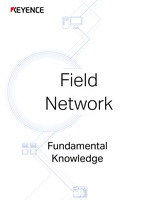CUnet
This section explains CUnet.
Overview
CUnet is an open network developed by Step Technica Co., Ltd. It was developed to reduce the work needed to develop communication programs for data sharing in control systems that use large numbers of CPUs, by using special ICs.
Wiring Method and Communication Protocol
Wiring method
CUnet is wired according to RS-485. It supports bus topology and the transmission rate can be selected up to 12 Mbps. Up to 64 stations can be connected, and the cable can be extended up to 300 m (984.3′) (at a transmission rate of 3 Mbps and up to 100 m (328.1′) at 12 Mbps).
Communication protocol
CUnet uses its own protocol. The CUnet protocol is provided in the form of a special IC. Using the CUnet protocol, information on connected CPUs can be shared by all connected CPUs, and the shared information can be read and written from the main CPU. This reduces the work needed to create data sharing programs for equipment using multiple CPUs.
Characteristics
Using time-sharing, CUnet shares data by communicating with each CPU during allocated time in sequence. It also supports email transmission to individually transmit data between CPUs.
Time-sharing
CPUs calculate the frame time from the number of connected CPUs and data size and then calculate the cycle time from the total frame time, thus sharing the data sending timing of each CPU. Information on all CPUs connected to the CUnet network can be read out from any CPU because shared data is stored in the common memory of each CPU.
Email transmission function
Information can be shared individually by mailing to specific CPUs. The mail transmission function sends data divided at the time-sharing timing, and the email reception flag of the destination CPU is turned ON when it receives all data.
Related Networks
HTTP Live Streaming (HLS)
This is a network provided by Step Technica Co., Ltd.
The master manages information on all slaves using the master/slave method.
- Company, product, and network names mentioned on this page are either trademarks or registered trademarks of their respective companies.
- Note that some information, such as applicable standards and specifications, may have changed since this page was published.
November 2015






